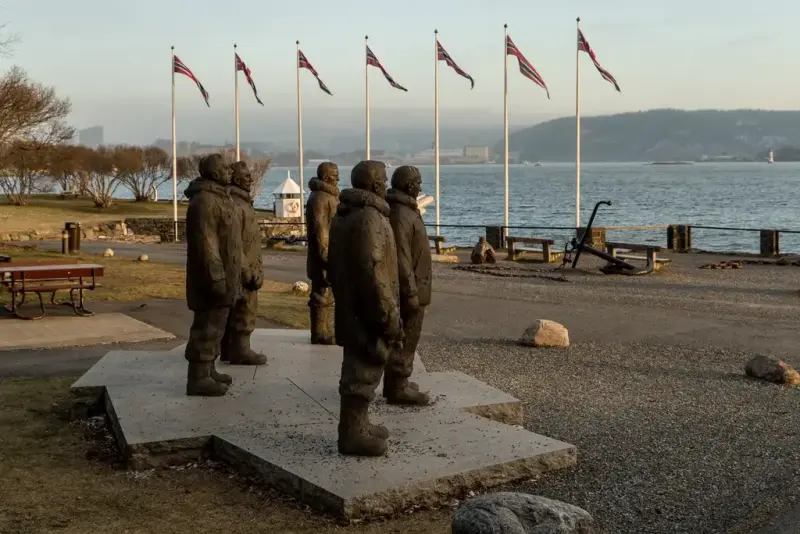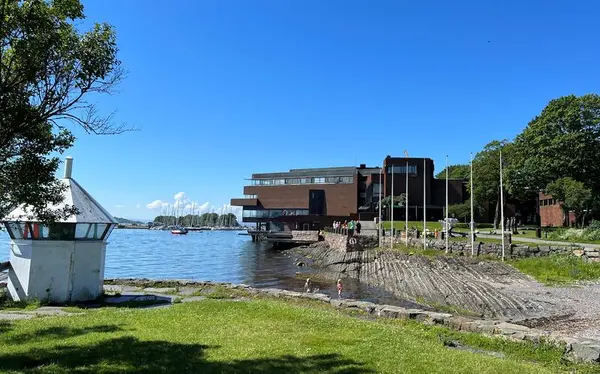- 1/1
The area features several sculptures and memorials, and in the museum harbor, there are both traditional boats and the sailing ship Svanen.
Sculptures and Memorials

The Amundsen Monument
Polar Explorers in Bronze
On December 14, 2011, exactly one hundred years after the Norwegian South Pole Expedition reached the geographic South Pole, King Harald unveiled this memorial sculpture in bronze and granite. The expedition members were: Roald Amundsen, Olav Bjaaland, Helmer Hanssen, Sverre Hassel, and Oscar Wisting.
Håkon Anton Fagerås' sculpture is a dramatic representation of all five participants who reached the pole. Now they gaze out over the Oslo Fjord and southward.
The monument has become very popular among visitors and is perhaps one of the most photographed objects at Bygdøynes.
The monument was erected by the Committee for a National Memorial to Roald Amundsen and is managed by the Cultural Department of the Oslo Municipality.
 Heidi Thöni Sletten | Norsk Maritimt Museum
Heidi Thöni Sletten | Norsk Maritimt Museum The War Sailor Monument
War Memorial 1940 — 1945
"Like a million soldiers." These words belong to Winston Churchill. This is his assessment of the efforts of sailors on Norwegian ships during World War II. Several thousand died, and many were left permanently injured even if they survived. Their contemporaries showed little understanding of what they had endured.
This memorial by Joseph Grimeland (1916-2002) was unveiled by King Olav V in 1980. After more than 30 years of silence, the monument marked a nascent recognition of the Norwegian war sailors. The initiative for its erection had to come from the sailors themselves.

War memorial 1914–1918
In addition to the War Sailor Monument for World War II, there is a memorial on Bygdøynes commemorating the sailors who lost their lives at sea during World War I.
Approximately 2000 sailors on Norwegian ships perished in wartime sinkings during the war.
The monument bears the following inscription: "In memory of our sailors' great contribution to the homeland during the World War 1914-1918. Erected by Christiania Seamen's Association 1921."
 Norsk Maritimt Museum
Norsk Maritimt Museum Sjøblomst (‘Sea Flower’)
Boat Refugees' Gratitude to Norway
The sculpture Sea Flower is a gift, given in gratitude after a fundraising effort, from Vietnamese boat refugees and their descendants. The memorial is a gift to Norway and Norwegian society.
After a dramatic escape, the refugees were picked up by Norwegian ships and were given the opportunity to build a future in Norway.
The Sea Flower stands in the water east of Bygdøynes and was created by sculptor Thor Sandborg. The monument was erected by the Project Group for the Vietnamese Refugees' Memorial and is managed by the Cultural Department of the Oslo Municipality.
 Beate Kjørslevik | Norsk Maritimt Museum
Beate Kjørslevik | Norsk Maritimt Museum The Seamen’s Choir Memorial
In memory of those who died at sea
This monument originally stood outside the Seamen's Church at Bygdøy. When the property was sold in 2014, the museum, in collaboration with the Norwegian Seamen's Choir and the owner, ensured that the memorial was relocated to Bygdøynes.
On Liberation and Veterans Day, May 8th, the Norwegian Seamen's Choir has a tradition of laying wreaths at the monument in memory of those who lost their lives at sea.

Inuksuk
Cairn for Friendship
The stone sculpture or cairn, shaped like a human figure, is called an inuksuk in Canada (often spelled inukshuk in English, but inuksuk is the official term now). They have been used both as guiding cairns and as symbols of friendship. The inuksuk is a gift to Norway from Canada as a symbol of our deep historical connections.
It is crafted by sculptor Joseph Suqslak from Gjoa Haven in the Nunavut territory in northern Canada. The sculpture was inaugurated in 2005.
Roald Amundsen's Gjøa expedition spent three years in Gjoa Haven - the place was named after the polar ship.
The Museum Harbor

'Gjøahavn' - Gjøa harbour
In the museum harbour at the Norwegian Maritime Museum you can see Norwegian wooden boats from all parts of the country.
Norway has a strong boatbuilding tradition with clear local characteristics. The boats were designed based on local needs and the waters where they would be used.
Some are easy to row and can take many passengers, others can sail well in shifting winds, while others again are made for heavy seas and fishing far from the shore.
These boats, which are privately owned and organized through the Gjøahavn Boat Owners’ Association, represent fine aspects of Norwegian coastal culture.

SS ‘Svanen’ - The Swan
The SS ‘Svanen’, the only preserved sailing ship from Norway’s golden age of international seafaring, has survived World War I and a long period as a freighter, and was in a dilapidated state when she was saved and brought back to Norway as a trainingship.
Since 1973,‘ Svanen’ has had Bygdøynes, Oslo, Norwegian Maritime Museum as its home port.
The schooner ‘Svanen’ was built at Svendborg on the island of Funen, Denmark, in the winter of 1915–1916. While still on the building slip she was sold to a shipping company in Arendal, Norway, and baptized ‘Smart’ at the launch.
In the boom years during World War I she had a number of successive Norwegian owners. She survived the German submarine war, and in 1921 she was bought by a Swedish shipowner and baptized ‘Svanen’. She was furbished with an engine and served asa cargo freighter until the early 1960s.
In 1965, "Svanen" was repurchased for Norway as a vessel preservation project and was once again rigged as a three-masted topsail schooner to sail as a training and school ship. In 1973, the ship was donated to the Norwegian Maritime Museum and has since sailed as a "sailing school" and on voyages with younger crews during the summer season.
The ‘Svanen’ represents the last generation of medium-sized sail-driven cargo freighters that were in service partly in coastal navigation and partly in trade in the North Sea and Baltic Sea. She is the only preserved three-masted ship from the Norwegian merchant navy. ‘Svanen’ is a floating cultural heritage object, a major communication arena for the museum and an ongoing educational project.
